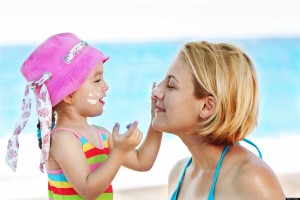
Sun protection creams are recommended to use with small children rather than sprays.
Summer is fast approaching, which for many people means that it is time to enjoy some sun, sea and sand. Without wishing to dampen spirits, it’s also an important time to remind yourself and your family to take care in the sun.
We have compiled a list of 5 need-to-know tips to help you choose an effective sunscreen, with the help of the Environmental Working Group’s Guide to Sunscreen.
1. Sun sprays can be dangerous
The most popular sun protection products on the market are sprays because they are easier to apply and less sticky than normal sunscreen. Sprays are also handy when applying on children, which can often be quite a struggle.
The problem with sun protection sprays is that they cloud the air with tiny particles which is not be safe to breath which is particularly dangerous for little ones. It is also easy to apply too little and/or miss a spot meaning that you are not adequately protected from the sun.
2. A higher SPF is not always better
Many studies show that people are easily misled by high protection factors, and believe that the higher the factor the better the protection. In reality however, there is little difference in terms of protection between factor 50 and factor 100. The problem is that people are quick to trust the sky-high SPFs believing that they will be protected for longer. This mentality is dangerous because people are less cautious in the sun.
EWG are also concerned that some of the ingredients in in high SPF sunscreens are harmful, with the potential to cause tissue damage, hormone disruption and allergic reactions after penetrating the skin.
3. Avoid certain ingredients
Oxybenzone is an active ingredient in sunscreens that is used in half of all protection products. When it penetrates in the skin it can trigger allergic reactions. It has even been linked to the cause of certain disorders.
Retinyl palmitate is a form of vitamin A and is found in one in five products and has been linked to the development of skin tumors and lesions.
4. Sunblock, sunscreen, waterproof & water-resistant – what’s the difference?
Colourless sunscreens absorb the UVA and UVB rays so they don’t completely penetrate the skin (keeping most rays out, but letting some in), while sunblock literally blocks these rays by reflecting the sunlight from the skin. A product is water-resistant when it still has the same SPF level after 40 minutes in the water, while waterproof maintains this level for 80 minutes of water exposure.
5. European sunscreens are the best
Among the 27 chemicals used in sunscreens, there are seven chemicals with strong protection against UVA rays. All seven of these chemicals are used in European sunscreens, whereas the American Food and Drug Administration has still not approved the use of all chemicals in the United States.
Don’t let the efforts of health organisations go to waste, listen to the tips and choose an effective sunscreen product to protect your skin and the skin of your family.
